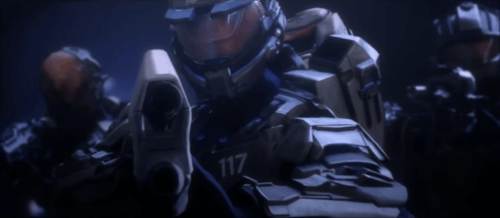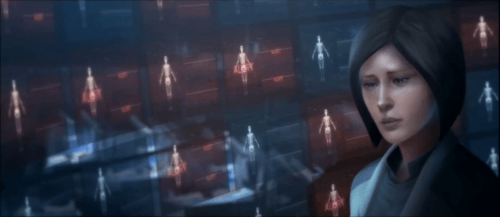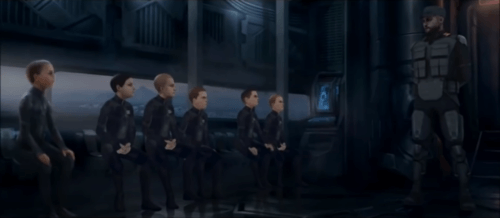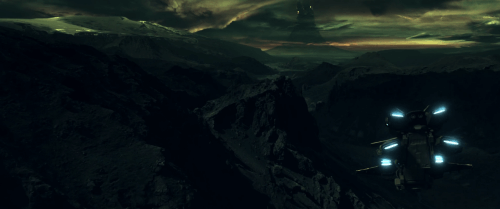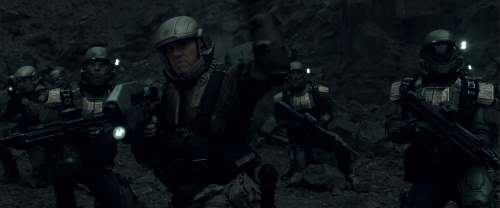With my decision to skip out on the Xbox One meaning I’d likely never play Halo 5, I stayed oblivious to both the considerable amount of pre-release hype and the immediate post-release criticism around the game. That’s not to say I don’t know anything about it as these days it’s difficult to find yourself in any sort of Halo community without stumbling across a ridiculous meme bashing Spartan Locke. Indeed, the game has a remarkably terrible reputation, often slated for having the worst campaign of any of the mainline Halo games. This means I was totally intrigued to finally play it, but my expectations weren’t exactly high.
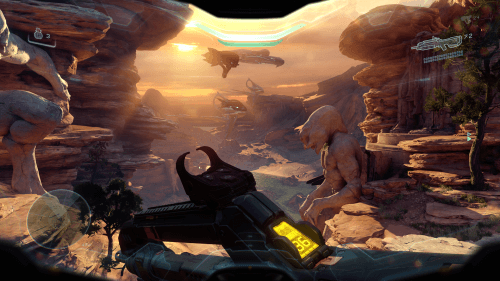
“Guns down in Sanghelios.”
Graphically, the Halo franchise’s entry into the 8th generation definitely didn’t disappoint and of course Halo 5 continues the tradition of featuring levels that span across diverse environments which helps showcase this, the awesome “glassed” moon Meridian and the beautiful Elite homeworld Sanghelios being particular standouts. Quite a nice looking game with all of the little touches and polish you’d expect from the series. Technical fidelity aside, 343 Industries continued the stylistic overhaul they started with Halo 4, bringing more of an overall cohesion to the designs of the UNSC. Some of these changes, such as with my beloved Scorpion tank, were perhaps the biggest departures from Halo: CE yet, while still quite respectful of their classic designs. The Covenant and particularly the Prometheans were similarly given a fresh coat of paint.
Things fare a little worse when it comes to gameplay. For the first time in Halo Fest 2020, I was struck by how different Halo 5 felt to play. It’s hard to describe, but it didn’t quite feel like Halo anymore. It was as if the series was moved to a new engine without much care being put into trying to replicate the feel of the previous one. On top of that, the overhauls I mentioned above didn’t stop with the graphics, with many weapons being heavily reworked as well. The classic Assault Rifle / melee combo I’d used as my crutch in literally every game since Halo: CE no longer felt quite as effective. Of course, I quickly got used to all of this and adapted, but I have to imagine that this is a big part of why fans heaped so much praise on how Halo Infinite feels to control.
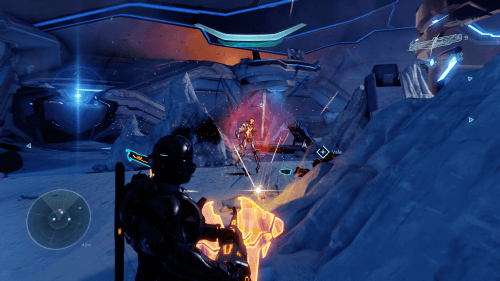
“Atomizing a Promethean Soldier with a Splinter Turret.”
Gone are the armor abilities that had been evolving since Halo 3, replaced instead with some inherent “Spartan Abilities”. You can now sprint at will, have built in thrusters to propel you directionally, and you can also perform special charge and ground pound attacks. The charge in particular is used a lot in the campaign to break through walls, unlocking secret stashes or alternate routes. There’s also a new ledge grab, which improves jumping and climbing quite a bit. I’m honestly not sure how “Halo” it all feels, but you’ve definitely got dramatically more maneuverability than ever before. Not technically a Spartan Ability but “assassination” melee moves are also a prominent part of the game now too. Another core change is that all weapons have an “aim down sight”-like system of zooming which is helpful without going all the way into Call of Duty territory.
Speaking of weapons, new to Halo 5 we have the tracking UNSC mini rocket launcher, the Hydra, the Covenant Plasma Caster, which is kind of a combination of the old Concussion Rifle with an alt-fire mode that charges up to fire a high damage projectile, and the Promethean Splinter Turret, which feels like some sort of cannon, and I absolutely grabbed it every time I had the opportunity. They also replaced our beloved SPNKR missile launcher with a totally new model that tracks like in Halo 2. On the vehicle front, the most notable additions are the UNSC Wasp, yet another Hornet and Falcon like aircraft, and the Phaeton, something of a Promethean equivalent. As mentioned, quite a lot of the weapons were tweaked and adjusted, with the Promethean weapons in particular being heavily altered. While I might prefer the old Suppressor, at least it feels like a distinct weapon now.
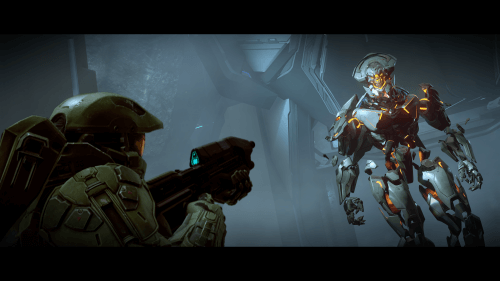
“Chief finally meets the Warden.”
Oddly, the difficulty struck me as a bit more brutal than the last few games. Playing on “Heroic” as usual, I felt like I could be killed in only a few shots, encouraging further engagement distances and a bit less aggressive play than usual for me. When things did go pear-shaped, my squadmates could usually be trusted to save the day and revive me. That is, for the first time in the Halo series, every single mission has you running as part of a four person fireteam. You have a single context sensitive button, being able to order them to go to a particular location, get in a vehicle, pick up a weapon, engage an enemy, etc. This works reasonably well, but is a far cry from the highly tactical experience I first dreamed of when hearing about Halo: Reach, largely thanks to the AI squadmates being absolute blithering idiots. At least they give us plenty of banter during missions…
The missions themselves are quite quick. If I hadn’t been obsessively scouring every map for hidden intel and skulls I think I would have wrapped up Halo 5’s campaign in record time. This wasn’t an issue for me though; the game was paced with a momentum that never left me ever stopping to wonder if I was bored, even with the addition of a few new “guns down” areas where all you’re expected to do is wander around and talk to other characters. Really, my only major complaint around the campaign structure and level design is with the repeated Warden Eternal boss fights, and even if it was a bit repetitive running into this goon over and over again, the fights were at least a fun challenge.
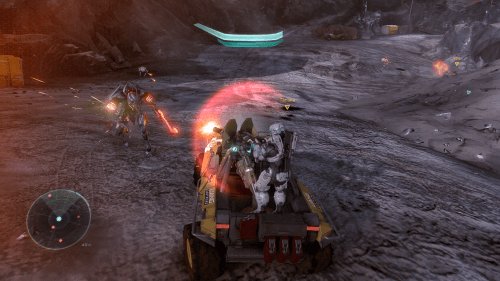
“Filling a Promethean Knight full of lead.”
Since I griped about them quite a bit during my Halo 4 post, I should mention that the Prometheans have been pretty thoroughly reworked. Knights are now mini-bosses, complete with a “shoot parts off their armor” mechanic for taking them down, and they, along with the Watchers, appear a lot less frequently. Crawlers also appear a lot less, and in much smaller groups when they do. Instead, the Promethean roster now includes a new type of humanoid robot called a “Soldier”. Soldiers can teleport, though not as a frustrating way of fleeing from firefights as with Halo 4’s Knights, and they can wield a variety of weapons, including the above mentioned Splinter Turret. All in all, this version of the Prometheans is far less of a chore to fight and personally, I’m pretty damn happy about that.
So, by now I must have mentioned at least half a dozen things that you might imagine could be responsible for the derision this game constantly gets from the Halo community, but not so fast! I think it’s time for us to talk about Halo 5’s story. Since I feel the need to nitpick it, and from Halo 4 on the games are only loosely connected anyway, I’m going to go ahead and summarize the plot right here. As usual I’ll keep it somewhat vague, but this, as well as the two paragraphs after it, will definitely contain spoilers. Skip the next three paragraphs if you want to avoid them!
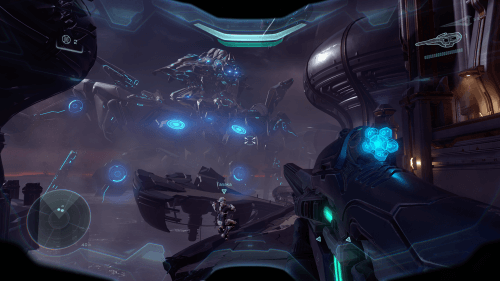
“Fireteam Osiris heading towards a distant Forerunner Guardian.”
The Story: Spartan Fireteam Osiris, led by Spartan Jameson Locke, is dispatched from the UNSC Infinity to rescue Dr. Halsey from Covenant faction leader Jul’Mdama. Once planetside, the Spartans find that the Promethean and Covenant forces have turned on each other. Taking advantage of the chaos, Osiris eliminates Jul’Mdama and his retinue and successfully extracts Halsey. Meanwhile, the Master Chief and his fireteam “Blue Team” are conducting a routine mission when the Chief sees a vision of Cortana, who gives him a cryptic message about the planet Meridian. Deciding to investigate instead of returning to the Infinity, Blue Team are listed as AWOL. Arriving on Meridian, Osiris tracks Blue Team to a Forerunner structure housing a Guardian, massive Forerunner ancilla built to police entire systems. Soon after, Osiris catches up to and briefly confronts Blue Team, but they’re able to escape onto the Guardian, leaving Osiris to hastily flee the structure and later the Meridian itself as the Guardian activates and jumps away to devastating effect. Blue Team arrives on an unknown Forerunner planet where Guardians from all over the galaxy are gathering. There Master Chief reunites with Cortana, who shares that when the Didact was defeated his ship performed an emergency jump to this planet, Genesis, where she was able to join the Forerunner data network, the Domain, curing her of her rampancy. She also reveals her plan to take up the Forerunner’s “Mantle of Responsibility” herself, enforcing a new era of peace across the galaxy, seemingly accepting the death and destruction this will inevitably cause. Eager to show Master Chief that her plan will work, she places Blue Team in stasis. Aboard the Infinity, Halsey hatches a plan to hijack a dormant Guardian located on Sanghelios, the Sangheili homeworld. Despite being embroiled in a civil war against the remnants of Jul’Mdama’s Covenant, the Arbiter and his Swords of Sanghelios get Osiris to the Guardian just as it is about to jump away. On Genesis, Osiris, with the help of the planet’s caretaker AI, 031 Exuberant Witness, is able to wrest control of the planet’s systems away from Cortana, freeing Blue Team in the process. Cortana and her fleet of Guardians jump away to continue with their plan. Some time later, with innumerable AIs joining her cause, Cortana and her “Created” begin disabling ships and other technology all over the galaxy, sending the UNSC Infinity on the run.
From the cutscene at the beginning, which is the most over the top depiction of Spartans I’ve seen since “The Package” in Legends, I was bracing for the worst, but thankfully I found most of the claims of the story being a train wreck to be hyperbole. I think my aforementioned low expectations helped a lot, but, despite so much of the story between Halo 4 and Spartan Ops as well as other crucial background information (like who the hell Blue Team actually is, for one) being left to the most dedicated Halo fans to discover via novels and comics, I was able to follow the plot reasonably well. I admit, I was disappointed that the events of Spartan Ops were wrapped up in such an unceremonious way, but I’d probably be even more bummed out to have never played through Spartan Ops and have no idea why Halsey was hanging out with the Covenant and missing an arm, if I even knew who she was in the first place. Regardless, while there are many signs that maybe the game had been rewritten perhaps one too many times and I’m absolutely certain that a closer examination of the game’s plot would reveal it to be a swiss cheese of much more disconcerting plot holes, there are some very cool ideas here.
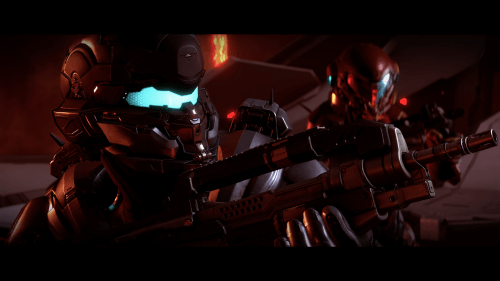
“That actual main character of Halo 5, Spartan Locke.”
A much more immediate issue is Halo 5’s dialog. I can generously interpret that 343 intended to depict Blue Team as “quiet professionals” but Master Chief hardly says anything and half of the little he does say is, well, just kind of stupid. It’s easy to imagine that after the traumatic loss of his only companion after so many months fighting the Covenant on his own he’s chosen to lose himself in his work, but the game doesn’t make any effort to show us that, and that is an example of what people really mean when they say Halo 5’s writing is bad. Cortana is the real standout to me though, as her physical depiction, voice acting, and even her behavior (like cruelly mocking the members of Osiris towards the end of the game) barely resemble the Cortana we know. Sure, this could be explained by everything that happened to her since Halo 4, but it just feels… off. Speaking of Osiris, it’s absolutely mind boggling that, after the well-known fan backlash over playing the Arbiter for a third of the game in Halo 2, 343 would have us playing Locke and Fireteam Osiris for all but three of the 15 missions in Halo 5. *facepalm*
While I could go much, much further, this is already getting too long. I actually enjoyed the game quite a bit more than I was anticipating. Still, it fails to continue Halo 4’s character development of either Master Chief or Cortana and it fails to wrap up the events Spartan Ops set up in any meaningful way. Indeed, it also sounds like, despite introducing a huge new threat and ending on somewhat of a cliffhanger, it doesn’t connect in an important way to the story of Halo Infinite either. So, while maybe Halo 5 might not deserve every bit of the ridicule it gets online (and indeed, much of the community was quite fond of its multiplayer, and its Forge is supposedly incredible) that doesn’t exactly make it an impressive entry into the series either.
To briefly carry on the tradition of talking about live action media around the series, the “Hunt the Truth” campaign advertisements The Hunt Begins, All Hail / The Cost, and A Hero Falls set up a seriously epic showdown between the Chief and Locke, which, yeah, isn’t even close to what happened. Ooops! What was it I said about too many rewrites again?
